Preface: The tragedy of thousands of Syrian refugees trapped in al-Rukban refugees’ camp, on the Jordanian-Syrian border, has multiplied following several suicide bombings conducted by the self-called Islamic State, also known as ISIS. The explosions became another obsession that exacerbated the suffering of Syrian refugees/displaced, notably they already live in deteriorating conditions; the last blast was on May 15, 2017, when several civilians were killed and dozens were injured because of a car bomb that hit the main camp’s market, according to Syrians for Truth and Justice /STJ reporter in Daraa.
Al-Rukban camp lies near the Jordanian-Syrian joint border; about 25 km west of al-Tanaf border crossing point. The camp was built as a result of congregation of many refugees fleeing the armed conflict areas in Homs province, the Syrian desert/al-Badiya and the northern Syrian areas, given the Jordanian authorities prevented their entry in March 2015, on the pretext that numbers of Syrian refugees had exceeded Jordan's capacity. More than half of the refugee tents are in the demilitarized zone[1], while the rest lie in the Syrian territory, and the number of refugees in this random camp, located in a desert area, is estimated to be more than seventy-five thousand refugees according STJ reporter.
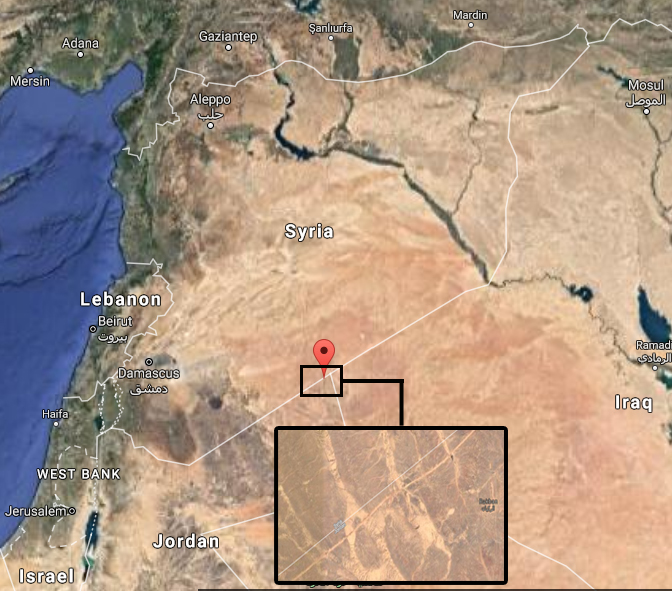
Satellite image shows the approximate location of the al-Rukban camp on the Jordanian-Syrian border, which is 25 km west of al-Tanaf border crossing.
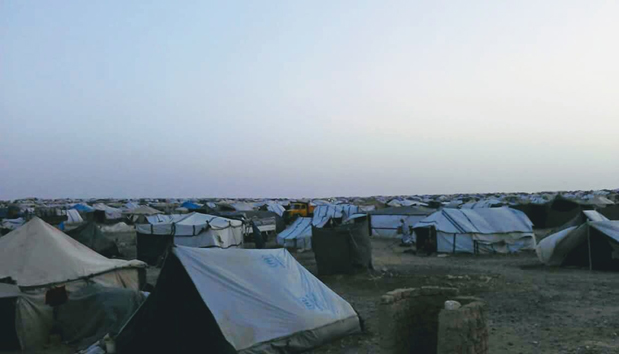
Image shows the tents of trapped Syrian refugees in al-Rukban camp located on the Syrian-Jordanian borders
Photo credit: activists from the camp
First: A Car and Motorcycle Bombing in the Folk Market in al-Rukban Camp
At 8 pm, Monday, May 15, 2017, two blasts hit the main camp’s market when ISIS targeted elements of the Army of Free tribes, also known as Jaysh Ahrar al-Ashayer[2], affiliated to the Syrian armed opposition with a bomb car during conducting security patrols inside the camp. When civilians converged to help the wounded from the first explosion, another blast occurred by an explosive –laden motorcycle, this increased the number of civilian causalities being killed or wounded, according to testimonies of the camp residents to STJ.
Faraj al-Faraj, a camp resident who displaced from Homs countryside, spoke to STJ about the two blasts that hit the main camp market, as he was close to the impact site and witnessed the moment of the blast, he said:
"Two explosions targeted the main market located in the north side of al-Rukban camp; the market contains many shops of foodstuff, vegetables and clothing, and is near a tank designated to sell fuel. The first explosion killed at least three civilians, alongside five of the armed opposition elements. After the second explosion, the number of civilian deaths doubled, the final toll was ten deaths, including a 12-year- old child identified as Muhammad al-Amour, from Palmyra. In addition to more than 20 wounded, who were dispatched to hospitals in the Kingdom of Jordan for treatment. Because of the severity of the two explosions, most bodies were scattered. "
The delay by the Jordanian authorities in allowing the wounded to pass and receive treatment- until the completion of the security procedures- until the next morning has worsened conditions of the wounded, who are seriously injured, and at least one of them has died. Notably, al-Rukban camp does not have medical facilities capable to cope with such serious cases, residents of the camp reported.

Image shows ISIS adopting the two suicide bombings that hit the main market of al-Rukban camp on May 15, 2017.
Photo credit: SITE Intelligence Group to monitor the extremist Islamic movements.
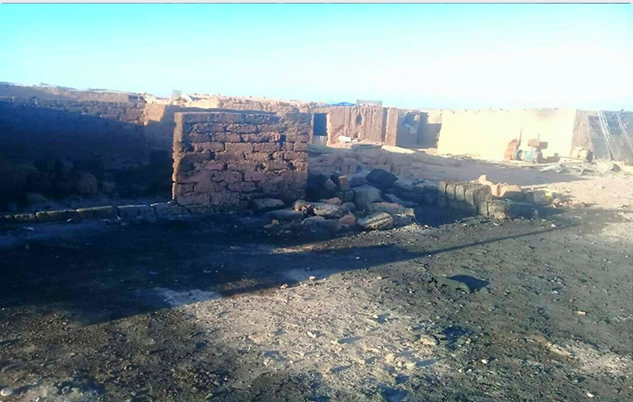
Image shows a part of the main market inside al-Rukban camp following the two suicide bombs on May 15, 2017.
Photo credit: activists of the camp

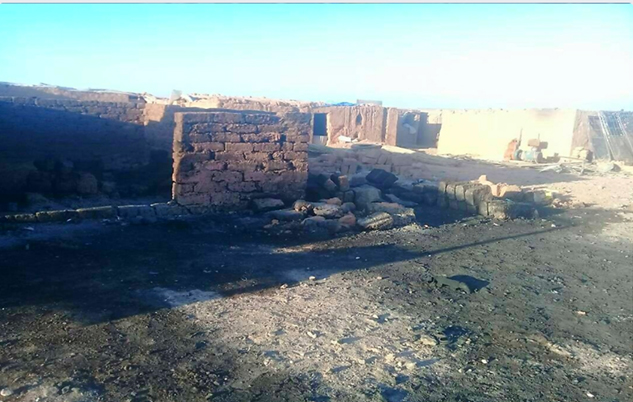
Two images show burning of some buses and shops following the two suicide bombings that hit the main market in al-Rukban camp on May 15, 2017.
Photo credit: Palmyra News Network.
On the other hand, Mohammad al-Adnan, a media activist, pointed to the effects of the suicide bombs that hit al-Rukban camp over the recent months, which exacerbated and worsened the medical status in the camp. He also noted that there was no operated medical center inside the camp because of losing the medical supplies needed for the emergency cases, he continued:
"Most of the serious cases caused by both suicide bombings have been transferred to the clinics located within the Jordanian territory at the border, specifically we are suffering from a disastrous medical situation, in the absence of doctors who immigrated or crossed to Jordan. Let alone the scarcity of medicines in the random pharmacies scattered within the camp. However, currently there are very few nurses and volunteers, as well as some high-paid midwives whom most of the camp people can’t afford."
Second: Difficulties Face Officials in Maintaining the Camp Security
Abu Majid al-Ahmad, the security official in the Army of Free Tribes inside al-Rukban camp, spoke to STJ about six suicide bombings that targeted al-Rukban camp in 2016 and 2017. He said:
“The Islamic State, also known as ISIS adopted most of the suicide bombings that hit the camp, the last was a bomb car “Kia 4000 and a motorcycle” on May 15, 2017; both targeted the commercial market in the camp. Those six explosions claimed the lives of 30 civilians, and more than twenty elements of the armed opposition. ISIS through explosions aims to create chaos and spread terror in the hearts of the camp residents. We later found out that there were security cells affiliated to ISIS within the camp, and we arrested many of them, moreover, the investigation showed that they helped facilitate those explosions.”
Being asked about the steps involved in preventing future suicide bombings, Abu Majid stressed the importance of imposing a security belt around al-Rukban camp, in order to control the entry and exit of the camp completely, and said
"The number of opposition elements designated for the camp security is only about 300, which is insufficient. Moreover, we do not receive enough support to secure the camp boundaries. Several months ago, we applied to the Jordanian authorities in order to provide the necessary support for digging a trench, building a sand berm around the camp, as well as the necessary equipment. However, the Jordanian authorities said our request was still under study. Currently we are trying hard to prevent the entry of any military vehicles of the Syrian armed factions into the camp particularly the entry of elements of many other factions, such as the Revolutionary Commandos Army, also known as Jaysh Maghawir al-Thawra, and Lions of the East Army, also known as Jaysh Usud al-Sharqiya. Given those elements come to visit their families frequently and cause a security disorder inside the camp."
Explosions that Hit al-Rukban Camp Since the Beginning of the Current 2017
Earlier this year, the camp witnessed three previous suicidal bombs. On May 4, 2017, ISIS adopted a car bomb explosion in front of a supermarket in the camp market that killed two civilians, one of them identified as Ismail al-Awfan, from Palmyra, Homs countryside, and injured several civilians who were there.
On April 9, 2017, a car bomb targeted several Syrian armed opposition military vehicles on the outskirts of the camp and caused three civilians casualties and scores of injuries. The explosion coincided with armed clashes, in the vicinity near al-Tanaf border crossing, between the Syrian opposition factions and ISIS on the backdrop that the latter attempted to sneak inside the camp. This may indicate that ISIS is responsible for detonation of the car bomb inside the camp.
At the beginning of the current year, on January 21, 2017, another explosion of a car bomb laden with junk in the vegetable market on the outskirts of the camp, killing seven civilians; some of them were identified as Hussein Ahmed al-Kamash, Ali Hussein al-Kamash, and Saleh Mohammed Joma’an al-Saleh", all of them were from Palmyra, Homs countryside. The explosion also injured scores, mostly women and children, who were dispatched to Jordanian territory.
Explosions Hit al-Rukban Camp in 2016
On December 17, 2016, a bomb motorcycle targeted a center for distributing relief items inside the al-Rukban camp, killed two residents of the camp identified as Fayez Hussein al-Mathhan and Hazim al-Hajij, as well as injured seventeen others, in addition to completely destroying the relief warehouse. On the next day of the bombing, ISIS broadcasted a footage showing the suicide bomber just before heading towards the impact site.
On October 16, 2016, a suicide bomber in a bomb car blew himself up at a guard point operated by the Army of Free Tribes, near the medical facility inside the camp, resulted in killing three civilians one of them is the young man Yamen Mahmoud al-Shagher, 18, from Palmyra , and injuring up to 10 other civilians. The Army of Free Tribes affiliated to the Syrian armed opposition blamed ISIS for the bombing.
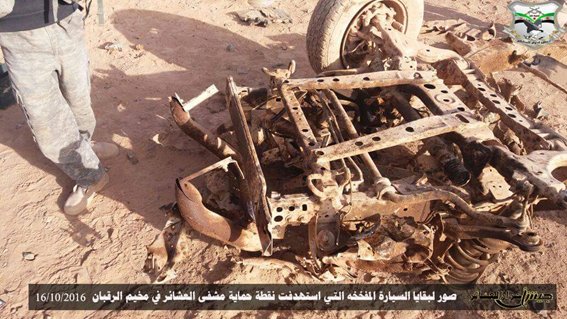
Image shows remnants of the bomb car detonated near the medical facility inside al-Rukban camp on 16 October 2016. Photo credit: the Media Office of the Army of Free Tribes.
It is worth mentioning that the first suicide bombing that hit the al-Rukban camp was on June 21, 2016, when a bomb car targeted a Jordanian military point, resulted in killing seven Jordanian security personnel and injuring four others, including civilians who were the near the site. ISIS adopted the operation and published a footage showing the moment of targeting the Jordanian military center.
Following this attack, the Jordanian authorities adopted a resolution to consider the al-Rukban camp a military zone and imposed restrictions on the movement of refugees towards Jordan; this increased the population in the camp as well as aggravated the daily suffering, notably with the shortages of food, water and medical supplies.
In this regard, Ghanim al- Hamidi, a displaced from Raqqa countryside and lives in al-Rukban camp, spoke to STJ describing the poor humanitarian conditions the people of the camp are living, saying:
In the camp, we are suffering from a major shortage of food, particularly bread. for a year, the United Nations has distributed food aid only three times, the most recently was last week, when the camp security officials shot gunfire on the pretext of organizing the queue and ending chaos. In terms of water, we cross a great distance to get to the water distribution place near the Jordanian berm; in addition, the medical care provided to us is almost non-existent. On March 31, 2017, the child Mohammed Fahad Al-Be’ejan died of a disease without being treated and, above all, ISIs every few time targets us with its car bombs."
[1] The Syrian and Jordan had agreed to install checkpoints on their lands with equal distances from the border, which created a demilitarized zone, each part is located in one of countries.
[2] The Army of Free Tribes runs the security matters in the al-Rukban camp and conducts patrols inside it in coordination with the Jordanian authorities that provide financial support as well as arms for this faction in order to maintain the security of the camp. In addition, it distributes the aid provided by the World Food Organization (WFO) every few months. The Army of Free Tribes/Jaysh Ahrar Al-Ashayer has fought several battles against ISIS in the Syrian desert/ al-Badiya and managed to control several ISIS-held sites; that what made the camp a targeted place of car bombs inside and outside the camp.

